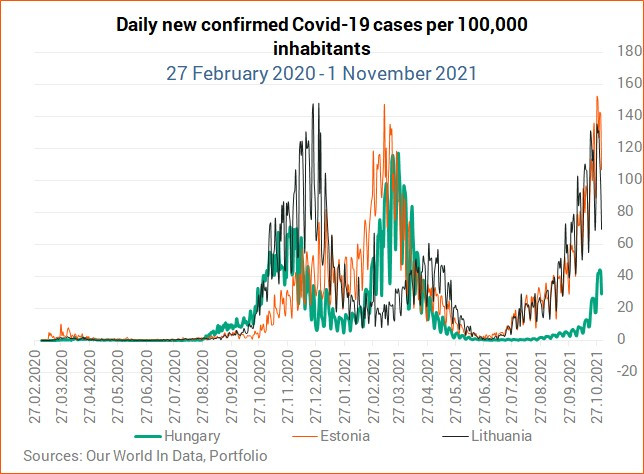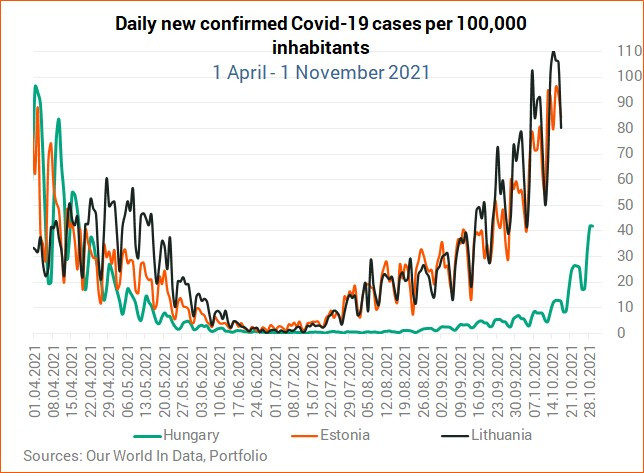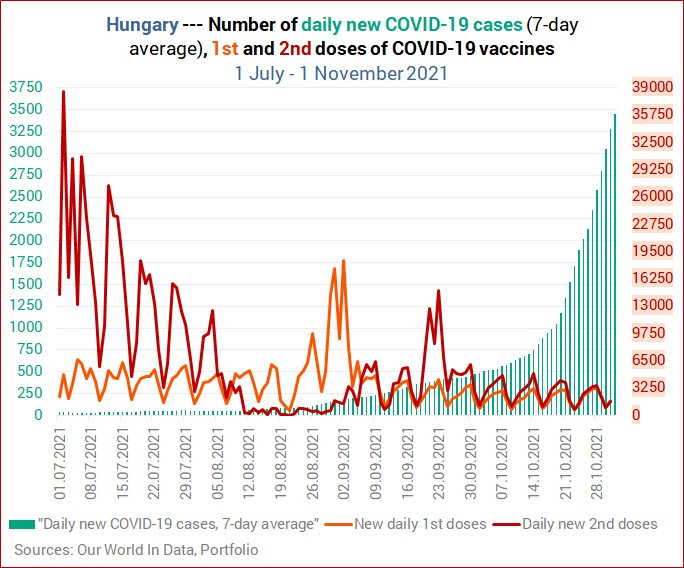COVID-19: What can Hungary learn from Estonia and Lithuania?

- Coronavirus spreading at an accelerated rate
The coronavirus pandemic is gathering pace in Hungary, with an increasing number of people being admitted in hospitals. It’s either that the ventilation protocol has changed since the previous ‘waves’, and they send people to ICUs sooner, or those admitted are generally in worse condition than a year ago.
- Vaccinations come to a halt
Meanwhile the vaccination rate is stuck around 60% and the pace at which people have been requesting third doses could / should also be higher. Although this sharp and accelerating resurgence of new COVID-19 cases has finally reached the cabinet’s sensitivity threshold and some restrictions were reinstated, the government bets almost solely on COVID-19 shots, while vaccine transparency is dramatically low.
- Authorities hush-hush on vaccination info
Authorities do not disclose – in fact they claim they do not even have – statistics regarding the vaccination status of the newly infected, hospitalised, or ventilated Covid patients or those that succumb to the disease.
- Why these two countries?
So, why are we comparing Estonia and Lithuania with Hungary now? For two reasons: (1) because their vaccination rate is similar to that of Hungary, and (2) they score largely the same on the Stringency Index. Their respective populations are vastly different, but comparison is still possible and worth it. Hungary’s 9.64 million compares with 1.33 mn inhabitants in Estonia and a cc. 2.7 mn population in Lithuania.
- Who gains what?
What we were hoping to gain from this analysis was a sort of guidance as to what could be expected in Hungary. Incidentally, the comparison could be more valuable for Estonia and Lithuania, as the epidemiological situation in general has been deteriorating dramatically in Hungary, and they could be facing the same predicament, given that the current ‘wave’ kicked off there three to four week later than in Hungary.
New COVID-19 cases
In terms of daily new confirmed COVID-19 cases per 100,000 inhabitants, Hungary is currently doing well compared to both Estonia and Lithuania.

The shorter-term chart shows rather wobbly curves, but it is evident that relative to the size of the population, the situation in Hungary was not as bad in the previous ‘wave’ and is still better currently. The key here is ‘relative to the population’. The 1st of April was chosen as our starting point to show the end of the previous 'wave' and the start of the current one.

In order to see the spread of coronavirus more accurately, not that we had any doubt about its high speed, and to avoid the heavy fluctuations, we need at least 7-day averages, and these graphs already tell a different story.


Covid hospitalisations
What’s more important in the current ‘wave’, however, is the number of Covid patients in hospital and on ventilator. Unfortunately, ‘Our World In Data’ offers no statistics either on ventilated patients or those in ICUs for these three countries, and it also lacks figures on active cases and recoveries therefore this comparison is far from being full. But it will do.
Once again, we have graphs for the long-term and the short(er)-term, which attest that Hungary has been faring better in this wave in terms of hospitalisations per 100,000 people (i.e. relative to the countries’ respective population), but it is quickly catching up with Lithuania.
The charts show that it has already surpassed it in terms of hospitalisations, but data for Lithuania and Estonia are up only to 24 October, whereas those for Hungary go up to 1 November. This one-week hiatus for Estonia and Lithuania can be observed on several other charts too.


The 7-day averages also show that the situation in Hungary is worsening at a rate greater than in either of its peers.


The sharply deteriorating situation in terms of Covid hospitalisations is even more obvious when we look at the 1 July – 1 November period.

Covid deaths
The pandemic was clearly the most devastating in Hungary in terms of 100,000 population (Hungary was a world recorder for a long time in terms of Covid deaths per one million people, until Peru dethroned it.)
As per a percentage of the population, coronavirus has been more deadly in Lithuania in the current ‘wave’ than either in Estonia or in Hungary.


The 7-day averages, however, put Hungary in the first place again



In terms of the Case Fatality Rate (CFR), Estonia and Lithuania are not in the same league, and Estonia has been particularly doing well in this respect.


So, how come Hungary's CFR is so much higher? It is because of the entirely different testing practices. CFR is the number of Covid fatalities divided by the number of confirmed cases. If you perform very few tests as Hungary does, you'll have massive underdetection. The number of deaths rise but the number of confirmed cases remains relatively low, hence the high CFR.
Let's just divide the number of total tests performed with the countries' respective population. Here are the results:
- Hungary - 77.35%
- Estonia - 162.6%
- Lithuania - 216.35%
Any questions?
Positivity rate
The following three graphs (shout-out to Balázs Pártos) show test positivity, only not in the usual way. The curves show the 7-day average of the 3-day / 21-day positivity rate. The black line is at 100%. Red is bad, green is good, yellow marks the transition between the two. This curve really shows when the pandemic ‘waves’ started. Look the end of May, early June. So, when you heard officials warning a week ago, two weeks ago, or even a month ago that the “fourth wave was starting”, it wasn’t. It had started a lot earlier. It could have been stopped or even stymied by at least 100,000 tests performed per day and very strict contract tracing. In the summer. But it’s too late for that. It has been too late for a while now.
In Estonia, the current ‘wave’ started a bit later, in late June, early July. About the same time as in Lithuania. (Note that the left-hand scales do not start at 0% for demonstrative purposes.)



Vaccinations
As regards vaccinations, Hungary’s coverage practically stopped around 60%, and if it keeps stagnating, the waning effectiveness of COVID-19 vaccines will actually lead to a drop in the vaccination rate, although 3rd doses remain much more in demand in Hungary than 1st and 2nd doses combined.




The pattern is eerily similar in Estonia and Lithuania in terms of 1st and 2nd doses. While the number of Covid cases, hospitalisations and fatalities rise, people in general still do not get vaccinated. Third doses are not even administered yet in Estonia, whereas Hungary made them available as early as 2 August this year, becoming the first to do so in the European Union.
Conclusion
There is none. It may be that we should not wait for authorities to tell us how to best protect ourselves against the virus. On an individual level we should do our utmost not to get infected, which includes getting vaccinated (yes, with third doses too, one you are four, five or six months after your second jab), social distancing, wearing masks in public, particularly indoors, beefing up our immune system by losing that extra weight, and by exercising every once in a while (let's say, a couple of times a week).
Other than these... yeah, nah. This ship has sailed. As noted above, we could have done something to avoid or at least mitigate the impacts of this 'wave' in the summer. Let's just hope that no new variant will emerge in the winter or next spring that will make us wish that Delta was still in the air.
If you still have doubts about where Hungary is headed in the current 'wave', take a look at the reproduction rate and how it took off over the past month or so, while it remained fairly levelled in Estonia and even dropped some in Lithuania. The reproduction rate has not been this high in Hungary since 7 September 2020.
Cover photo: Getty Images










